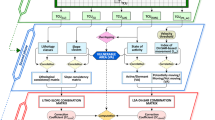Abstract
Landslides are a serious problem for humans and assets in many parts of Europe. Once an area where a landslide hazard exists is identified, then it is necessary to select the elements at risk exposed. This work reports the findings coming from a pilot study devoted to rank the buildings located in a large Italian region according their exposure to the landslide hazard. Our experience can be repeated easily elsewhere.
Access this chapter
Tax calculation will be finalised at checkout
Purchases are for personal use only
Similar content being viewed by others
References
Di Felice, P. (2014). Integration of spatial and descriptive information to solve the urban waste accumulation problem: A pilot study. Elsevier, Procedia - Social and Behavioral Sciences, 592–597. Doi:10.1016/j.sbspro.2014.07.636.
Di Felice, P. (2015). Integration of descriptive and spatial data to rank public buildings according to their exposure to landslide hazard. 5th International Conference on Integrated Information, Sept. 21–24, Mykonos, Greece.
Di Felice, P., et al. (2014). A proposal to expand the community of users able to process historical rainfall data by means of the today available open source libraries. CIT. Journal of Computing and Information Technology, 13(7), 382–388.
PAI-Abruzzo. Autorità dei bacini regionale abruzzese interregionale del fiume Sangro: Carta delle aree a rischio, PAI. Retrieved April, 2015 from http://autoritabacini.regione.abruzzo.it/index.php/carta-delle-aree-a-rischio-pai.
Rawat, P. K., Tiwari, P. C., & Pant, C. C. (2012). Geo-hydrological database modeling for integrated multiple hazards and risk assessment in Lesser Himalaya: A GIS-based case study. Natural Hazards, 62, 1233–1260. doi:10.1007/s11069-012-0144-2.
Author information
Authors and Affiliations
Corresponding author
Editor information
Editors and Affiliations
Appendix
Appendix

Rights and permissions
Copyright information
© 2017 Springer International Publishing Switzerland
About this paper
Cite this paper
Di Felice, P. (2017). Integration of Descriptive and Spatial Data to Rank Public Buildings According to Their Exposure to Landslide Hazard: A Case Study. In: Kavoura, A., Sakas, D., Tomaras, P. (eds) Strategic Innovative Marketing. Springer Proceedings in Business and Economics. Springer, Cham. https://doi.org/10.1007/978-3-319-33865-1_88
Download citation
DOI: https://doi.org/10.1007/978-3-319-33865-1_88
Published:
Publisher Name: Springer, Cham
Print ISBN: 978-3-319-33863-7
Online ISBN: 978-3-319-33865-1
eBook Packages: Business and ManagementBusiness and Management (R0)




